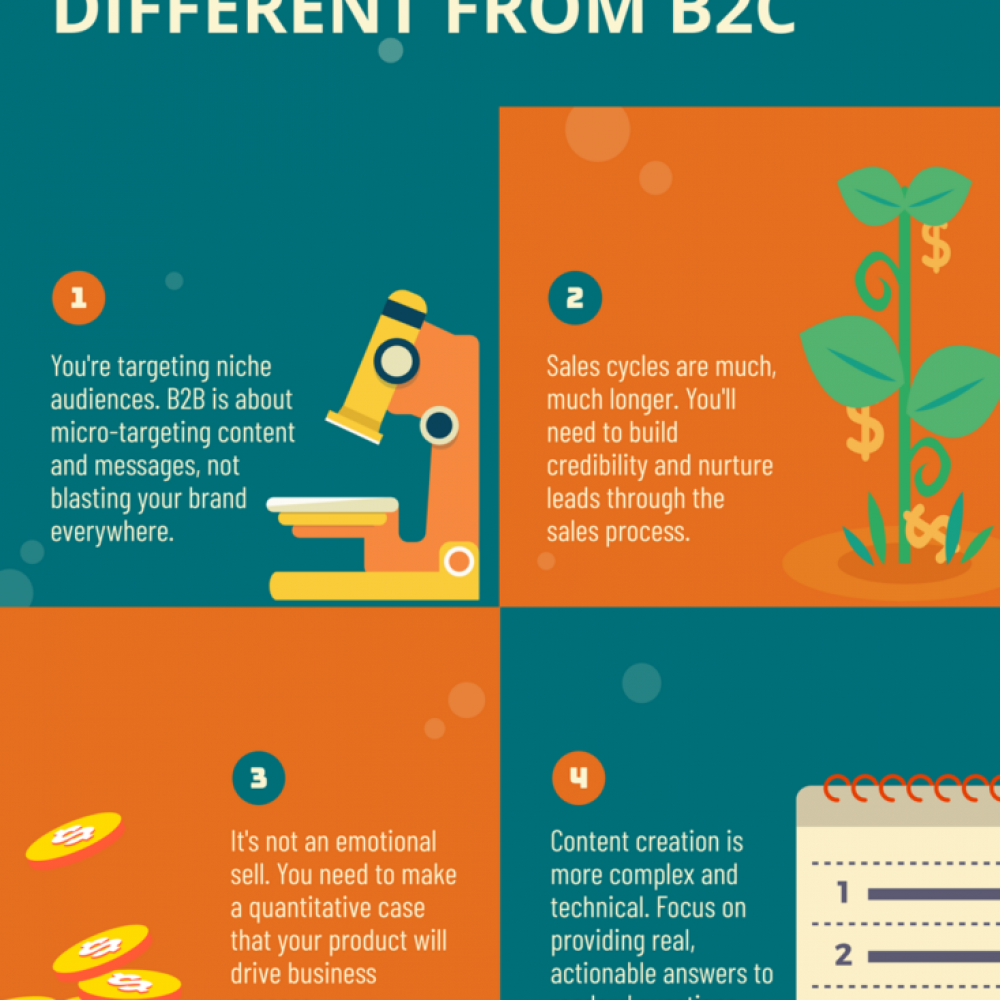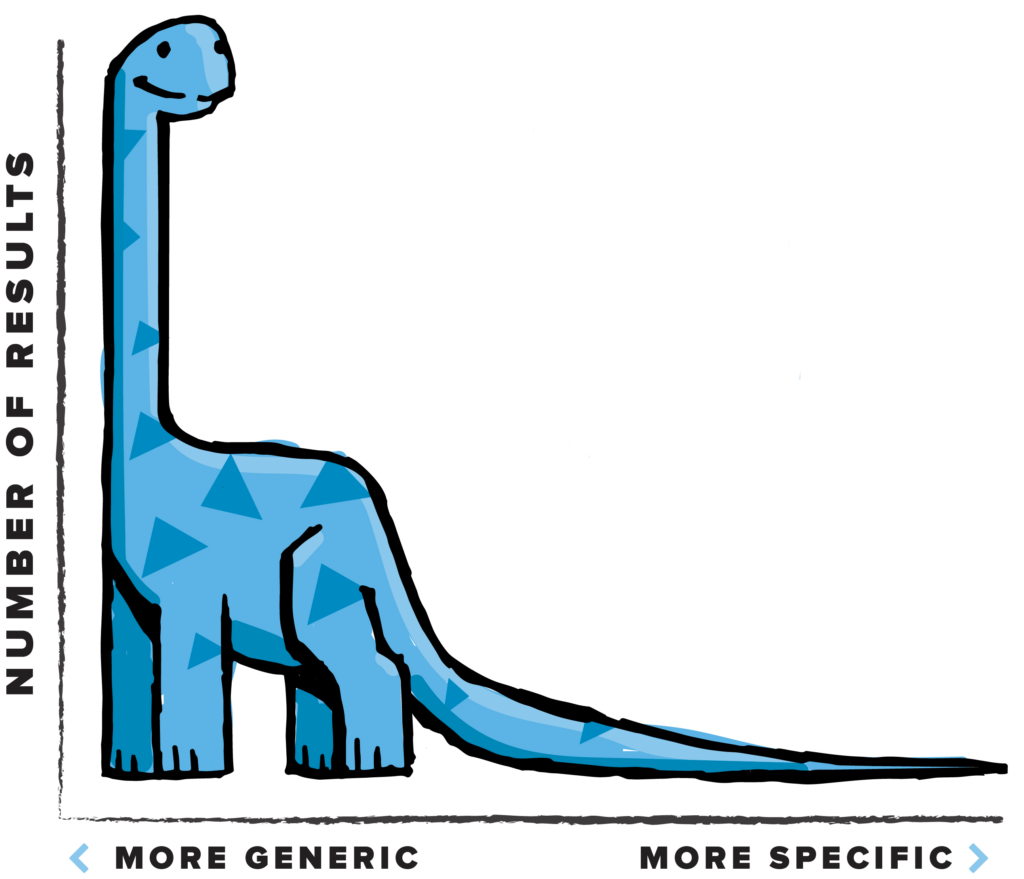Note: This blog was updated January 2025.
One of the biggest mistakes business-to-business companies make when trying to generate leads is marketing themselves like B2C brands. In this post, we take a look at what B2B marketing really is, and how it’s different from its consumer cousin.

First, a definition. B2B (business-to-business) marketing is marketing geared towards businesses or organizations. Nonprofits also fall under this umbrella, and governments are close. (Though we tend to call that B2G marketing. We’re all about acronyms here.)
B2B marketing differs from B2C (business-to-consumer) marketing in one critical way. B2C companies sell to end consumers of products and services. B2B companies sell to other businesses.
The B2B space is complex, both in subject matter and decision-making structures. And that means taking a very, very different tack than you would with B2C marketing.
What Is B2B Marketing? Four Ways It’s Different From B2C

How B2B Marketing Is Different From B2C
Niche Audiences
In B2B marketing, sales are typically low volume but high margin. Getting these sales entails marketing to niche audiences. There are simply fewer qualified buyers for sales tax audit support and eCommerce fulfillment than shoes.
This difference has tangible impacts that alter the approach to B2B marketing.
First, your key performance indicators (KPIs) are going to be different than B2C. Metrics like cost per lead and cost per acquisition are much more important than impressions and click-through rate. It’s OK to spend $1,000 or even $10,000 to acquire a customer if they’re going to pay you a million bucks over their lifetime.
Second, your SEO strategy needs to target more specific terms that have lower search volume. This is called “long-tail” SEO – you can read our guide to it here.

The Sales Process is Complex
A B2C sale can happen in a minute. A B2B sale can take a year.
Because business-to-business products and services are generally more expensive, businesses take longer to make a decision. If you’re marketing a product or service to another business, you can expect a much longer sales cycle.
Additionally, there will be more people involved in that decision. A B2C sale typically entails getting one person making the choice.
Selling B2B involves navigating a much more complex decision-making process, with multiple stakeholders at every level of the company weighing in on the decision. Identifying who the key decision makers are can prove challenging.
And when you do identify the decision makers, they’re often quite risk-averse. This is understandable. A major B2B purchase often involves gambling a significant portion of a department’s budget.
So how do you convince a risk-averse decision-maker in a complex decision-making structure and sales cycle to buy a product that they can’t touch or feel?
The bulk of B2B marketing efforts focus on solving this problem. There are three steps.
First, you need to show as much as you can. Would you buy a car that you’ve never even seen a picture of? Of course not. In the same way, businesses are going to be averse to buying software they can’t see, or a new service they can’t understand. SaaS products are particularly vulnerable to this challenge.
Black box functionality is your worst enemy here. Open the black box and show how you’re turning input into output. Your audience wants to understand how your product will integrate into their processes, and how exactly it will achieve the results you say it will.
Explainer videos are great for showing your product or service and what makes it great. Software demos give prospects the opportunity to see an enterprise system integrate with their data and workflows. Case studies tell a compelling story about your product demonstrates how you help your clients, from implementation through execution.
There’s plenty of room to get creative here. For example, if your product is stronger and more durable than all of your competitors, you can demonstrate this with video content that shows your product standing up to conditions that others can’t.
The second step is to build credibility. Testimonials and logo farms are great at showing website visitors that businesses like them are using the same technology to get results. Case studies help here as well. If you can show a prospect that other businesses are getting results with your product, they’ll be eager to learn more about what you’re offering.
The third step is to give them the information they need to decide. At this point you’ve convinced them that you have an effective offering that’s getting results for reputable companies. However, they might be hesitant to decide.
White papers, premium content and downloadable guides turn traffic into leads by giving them the information about your product and the industry in exchange for their email address. This also allows you to use drip marketing to nurture leads towards sales.
User Intent is Different
The goals and motivations of businesses and consumers are different. Unlike consumers, businesses are focused on achieving efficiency, cutting expenses and improving the bottom line.
When you’re engaging in B2B marketing and paid media, a strong value proposition is necessary to guide your strategy and marketing efforts. Everything – your product, your messaging, your content – should be directed at solving a problem for a business.
Fortunately, those problems aren’t hard to come by. Every business has goals and challenges. And the people responsible for them have pain points. It could be security, revenue growth, asset visibility or any number of issues.
Everything – your product, your messaging, your content – should be directed at solving a problem for a business.
Because of this, B2B buyer personas are going to need to include additional details, such as driving factors and goals. From there, you can tailor your value propositions to speak to the needs of the businesses and stakeholders you sell to.
Common B2B value propositions include:
- Streamlining workflows
- Performing the same process with fewer resources, materials or labor
- Doing more work in less time
- Complying better with government and environmental regulations
- Reducing error and inefficiency in key processes
- Minimizing or protecting against risk, liability, exposure
- Providing insights that increase sales
B2B Content Creation is More Complex
Great writing and content creation drive the backbone of every marketing strategy. But B2B writing involves tackling much more complex subject matter. Can you write about TVs? Great. Now try robotic process automation.
Consumers often don’t really care how their product was made or how it works. Just that it works. In contrast, businesses and stakeholders want to know the ins and outs of what they’re spending money on, how it works and how it will change their business processes. Because of this, B2B blogs will often be very technical.
B2B writing poses the unique challenge of communicating a difficult subject with enough detail that the reader is left satisfied while keeping it simple enough that someone new to your product will understand it.
Writing for B2B requires a lot more research and knowledge into complex topics. This involves a lot of research and access to a subject matter expert (SME). The process does get easier when you’re writing about a topic you’re already an expert in, but then you’ll still have to learn other industries for blogs that target specific niches.
However, a common pitfall in B2B marketing is to obsess over the details. The key is finding a balance. Be human, start high level, get to the details once you have someone’s attention.
How B2B Marketing is Similar to B2C
Despite the differences between B2C and B2B marketing, there is much that remains the same. The same marketing tools – SEO, landing pages, social media – are in play. Core branding principles are still vital. Content creation is still as important as ever.
All marketing writing and creative need great CTAs. Regardless of who you’re selling to, none of you’re marketing efforts will count for much if you can’t direct the prospect to the next step.
You’ll need a great website. There are best practices that change from B2C to B2B, but at its core you’ll need a stable, fast website that is easy for users and Google to navigate. No matter who you’re selling to, key marketing strategies such as SEO, retargeting and content rely on a website to function.
Conclusion
B2B marketing is full of complexities and challenges that require a specialized approach. If you’re looking to strengthen your marketing efforts, you’ll need a strategy that accounts for these challenges while generating leads and revenue.
Need help with your B2B marketing efforts? Drop us a line or call 610-421-8601 x122 to chat with one of our B2B experts.



